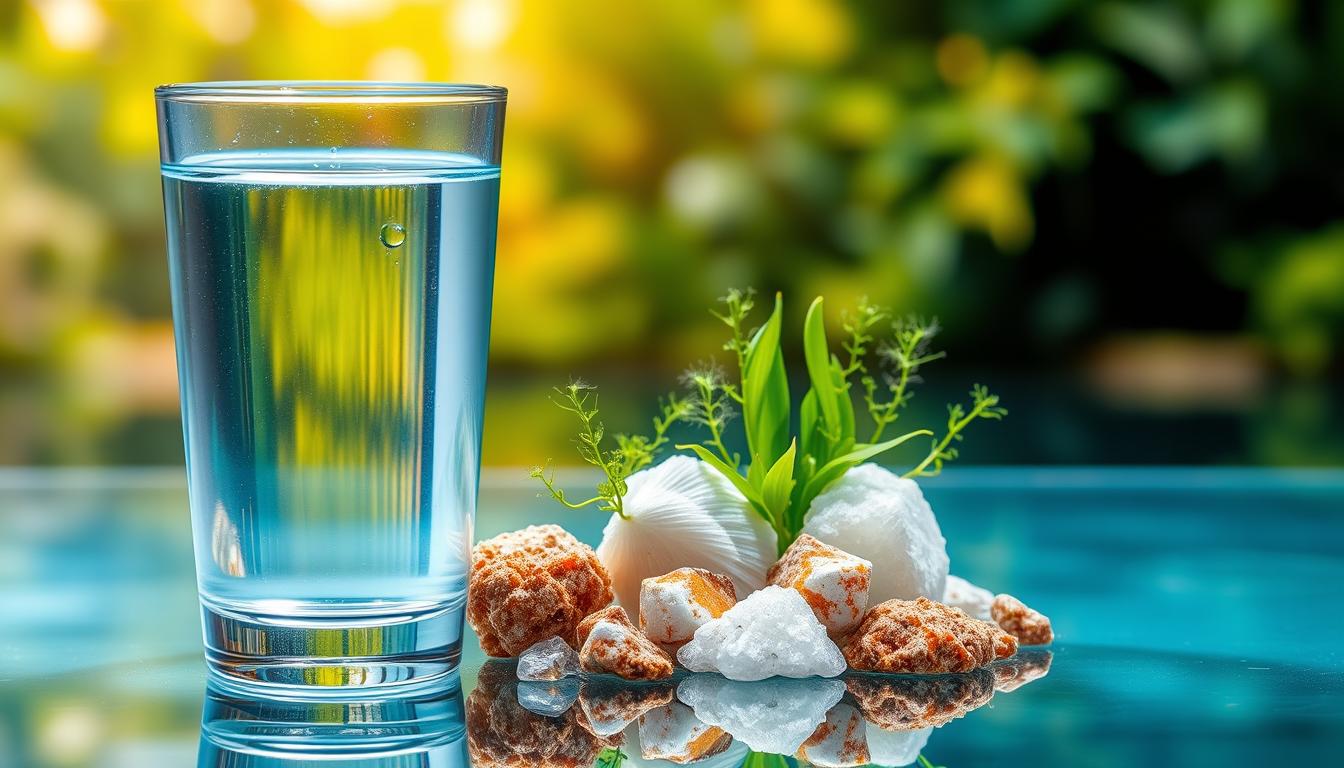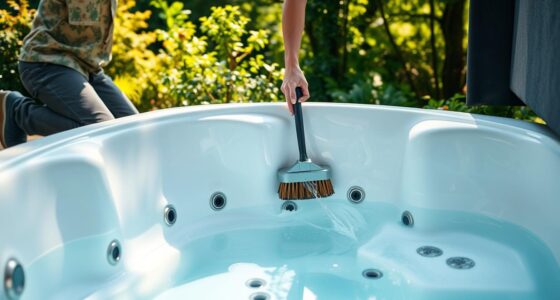Did you know that over 10 million residential swimming pools exist in the United States alone? Maintaining the water quality of these pools is essential for the enjoyment of millions of families every summer. One effective method to enhance pool maintenance is nonchlorine shock, a powerful alternative that helps achieve crystal clear water without the harshness of traditional chemical treatments. This article delves into the benefits of nonchlorine shock and provides practical usage explained, ensuring you’re well-equipped to keep your pool clean and inviting all season long.
Key Takeaways
- Nonchlorine shock is a safe alternative to traditional chlorine shock.
- It helps maintain clean water in your pool efficiently.
- Reduced irritation issues for swimmers, especially for sensitive skin.
- Less chemical use contributes to an eco-friendly swimming environment.
- Understanding dosage and timing is key for effective application.
- Nonchlorine shock products vary; knowing what to look for ensures quality.
What is Nonchlorine Shock?
The definition of nonchlorine shock refers to an alternative method for maintaining pool health, primarily serving as an oxidizer. This approach aims to balance your pool’s chemistry without the harsh effects often associated with chlorine shock. Nonchlorine shock products focus on breaking down organic contaminants such as body oils, lotions, and debris, fostering clearer and more inviting water.
Using these products means you’re opting for a gentler route in your pool care chemicals arsenal. Unlike traditional chlorine-based solutions, nonchlorine shock does not emit strong chemical odors, allowing for a more pleasant swimming experience. By incorporating nonchlorine shock into your routine, you contribute to a cleaner environment that is easy on both swimmers and your pool system.
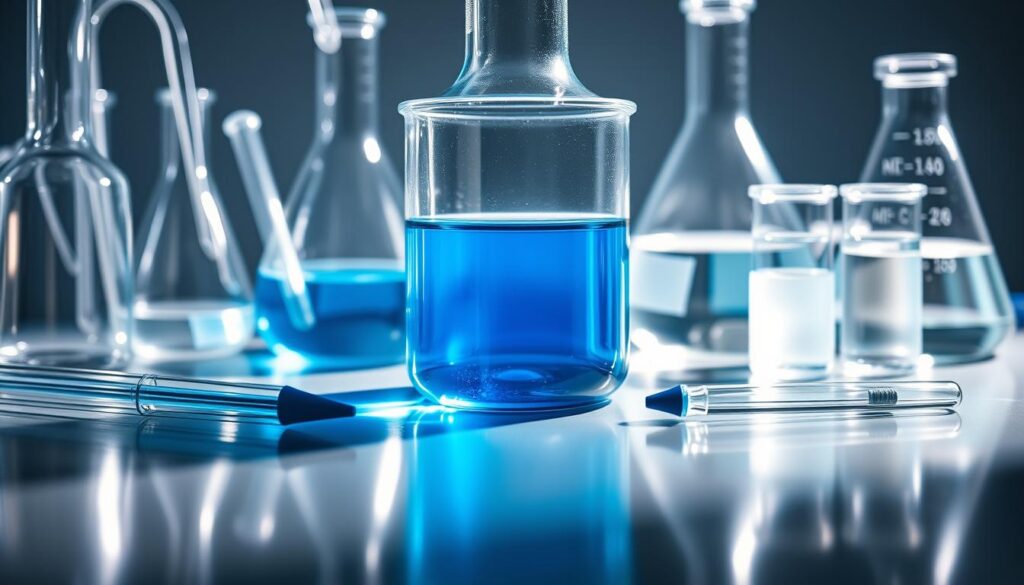
How Nonchlorine Shock Works
The mechanism of nonchlorine shock revolves around the use of powerful oxidizing agents that effectively break down impurities in your pool water. When you add nonchlorine shock to your swimming pool, it enters a rapid chemical reaction with organic materials such as sweat, oils, and contaminants. This reaction transforms these unwanted elements into harmless substances, ensuring a cleaner swimming environment.
In swimming pool chemistry, maintaining water clarity and quality is crucial. Nonchlorine shock aligns with this goal by promoting a balanced pool ecosystem. The oxidizing agents in nonchlorine shock not only disinfect the water but also help prevent the development of algae and maintain proper pH levels, enhancing the overall swimming experience for you and your family.
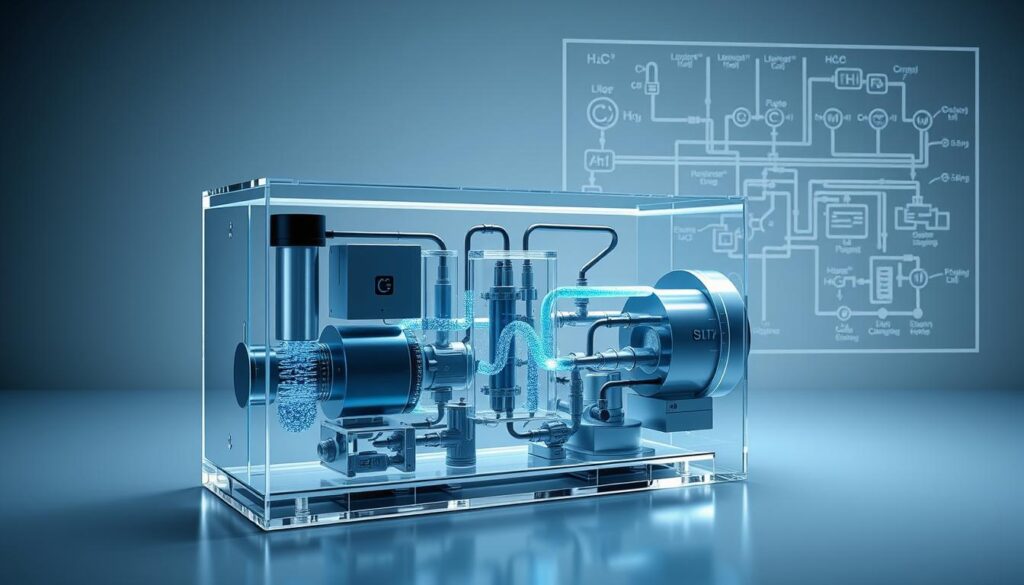
Benefits of Using Nonchlorine Shock
Incorporating nonchlorine shock into your pool maintenance routine offers numerous advantages. These benefits contribute significantly to creating a healthier swimming environment while enhancing your overall enjoyment of the pool.
Reduced Chemical Use
One of the primary benefits of nonchlorine shock is its decreased reliance on harsh chemicals. By utilizing this alternative, you can achieve clean water with less chemical usage, resulting in a more natural swimming experience. This reduction not only fosters healthier conditions for swimmers but also promotes a more eco-friendly approach to pool care.
Fewer Irritation Issues
Another notable advantage relates to pool irritation reduction. Nonchlorine shock does not produce the strong odors typically associated with traditional chlorine shock. As a result, swimmers often experience fewer issues with eye and skin irritation. This makes it particularly beneficial for families, including children and pets, who are more sensitive to chlorine’s harsh effects. Enjoying a dip in the pool becomes a more pleasant experience for everyone involved.
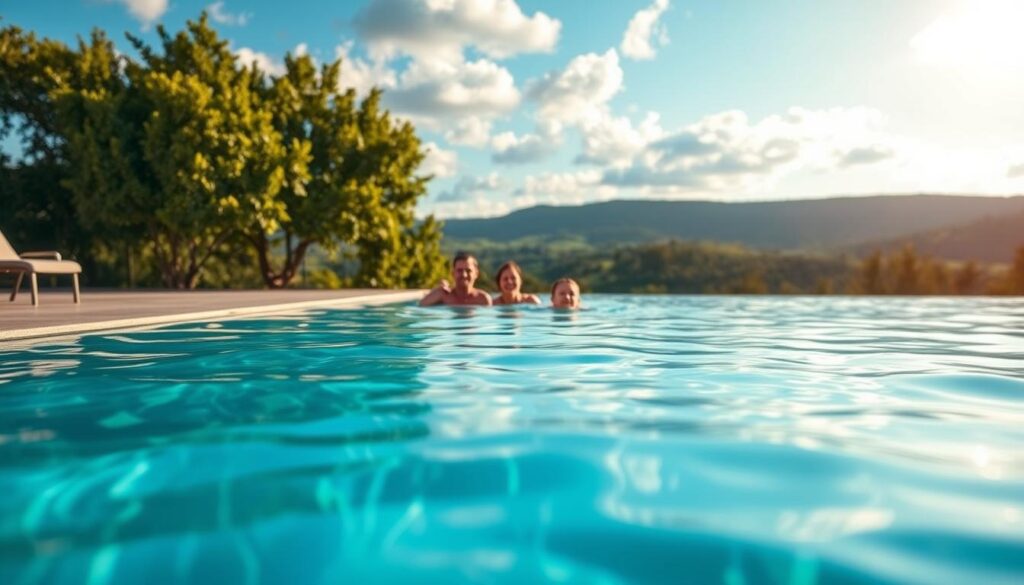
Comparing Nonchlorine Shock to Chlorine Shock
When considering pool maintenance options, understanding the differences between nonchlorine vs chlorine shock can enhance your decision-making. Chlorine shock has long been recognized for its potent sanitation properties. It effectively kills bacteria and algae, providing a quick fix for pool water issues. However, the effectiveness of nonchlorine shock lies in its gentler approach. This form of shock treatment uses potassium monopersulfate, which breaks down contaminants without the potent effects of chlorine.
A key aspect of the pool treatment comparison is their aftereffects on water quality. Chlorine shock can lead to harsh chemical odors and skin irritation, making it less appealing for frequent use. In contrast, nonchlorine shock offers a more pleasant swimming experience, with minimal side effects. With fewer harsh chemicals being released into the water, many pool owners find this approach preferable for regular treatments.
Another important factor is longevity. The effectiveness of nonchlorine shock may surprise you—while chlorine works rapidly, nonchlorine treatments often provide more extended protection against contaminants. This results in fewer chemical applications over time, enhancing overall pool water quality and swimmer comfort.

How to Use Nonchlorine Shock Effectively
Understanding the proper application of nonchlorine shock is vital for achieving the best results from your pool maintenance routine. This chemical not only helps clear water but also ensures that it remains safe for users. Implementing effective dosage tips and knowing the right timing for application enhances overall water quality.
Dosage Recommendations
Determining the correct dosage for nonchlorine shock application depends largely on your pool size. Typically, you should use two scoops for every 5,000 gallons. This is particularly important when preparing your pool for summer or closing it down for winter. Appropriate dosages minimize chemical fluctuations while keeping water health in check.
When to Apply
Timely application of nonchlorine shock plays a crucial role in maintaining your pool. Weekly applications help to neutralize contaminants, especially after heavy swimming activity. You may also opt for application following storms or significant debris accumulation to ensure clear, clean water during your next swim.

Understanding Nonchlorine Shock Products
When selecting the right nonchlorine shock for your pool, it helps to familiarize yourself with the different types available on the market. Each formulation varies in its efficiency and suitability for specific pool setups. By learning about these types of nonchlorine shock products, you can make informed decisions that enhance your pool maintenance routine.
Different Types Available
The types of nonchlorine shock typically include granular and liquid formats. Granular nonchlorine shock is often favored for its ease of use and effectiveness in raising chlorine levels quickly. Liquid variations provide a more straightforward application process and are convenient for those who want a quick solution without additional measuring. Each formulation comes with its own set of advantages, so assessing your pool’s needs can guide you in choosing nonchlorine shock products that work best for you.
What to Look For in Quality Products
When investing in quality pool chemicals, it’s essential to examine the product labels carefully. Look for ingredients such as chelated copper sulfate, which indicates a high-quality formulation. Researching manufacturer reliability through customer reviews ensures that you select nonchlorine shock options that deliver effectiveness and safety for your pool. Emphasizing quality will result in better water clarity and an overall improved swimming experience.

Nonchlorine Shock: What It Is & What It Does
The function of nonchlorine shock revolves around its powerful ability to enhance water quality in your pool. By employing oxidation, this treatment effectively breaks down contaminants, including organic materials like leaves, algae, and bacteria. This action ensures that your pool remains clean, clear, and inviting, making it more enjoyable for you and your guests.
Understanding the pool treatment benefits of nonchlorine shock is crucial for maintaining a healthy swimming environment. It minimizes the need for chlorine, which often leads to irritation in swimmers’ skin and eyes. Additionally, nonchlorine shock can efficiently eliminate odors and pollutants, enhancing the overall swimming experience. Incorporating this method into your routine ensures that your pool remains in top condition, fostering a refreshing oasis right in your backyard.
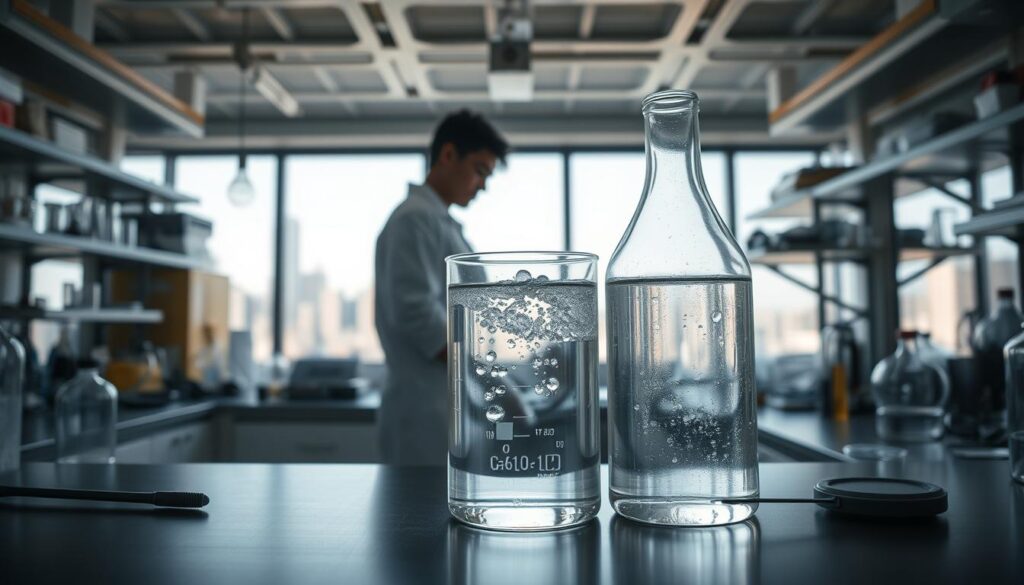
Adding Nonchlorine Shock to Your Pool Maintenance Routine
Integrating nonchlorine shock into your regular pool routine ensures that you maintain clean and healthy water throughout the swimming season. To effectively implement these nonchlorine shock usage tips, establish a consistent schedule for treatment. A weekly application works well for many pool owners, especially after heavy usage or following significant rainfall.
Pay attention to your pool’s water clarity and overall condition. If you notice any cloudiness or unusual odors, it may be time for a dose of nonchlorine shock. Keep an eye on the chemical balance and pH levels, as these factors also influence when you should apply the shock. Signs that indicate a need for additional treatments include swimmer complaints about water irritation or visible algae growth.
To simplify your pool routine integration, you might consider maintaining a pool log. This log should include dates of each nonchlorine shock application along with readings for pH and chlorine levels. This documentation helps you track the effectiveness of your routine and make adjustments as needed.
| Indicators for Nonchlorine Shock Application | Recommended Action |
|---|---|
| Weekly pool maintenance | Apply nonchlorine shock once a week |
| Cloudy water or strong odors | Apply shock immediately |
| Visible algae growth | Increase frequency of shock applications |
| Swimmer complaints | Assess water quality and shock if needed |
| pH level out of range | Adjust chemical levels and consider shock treatment |
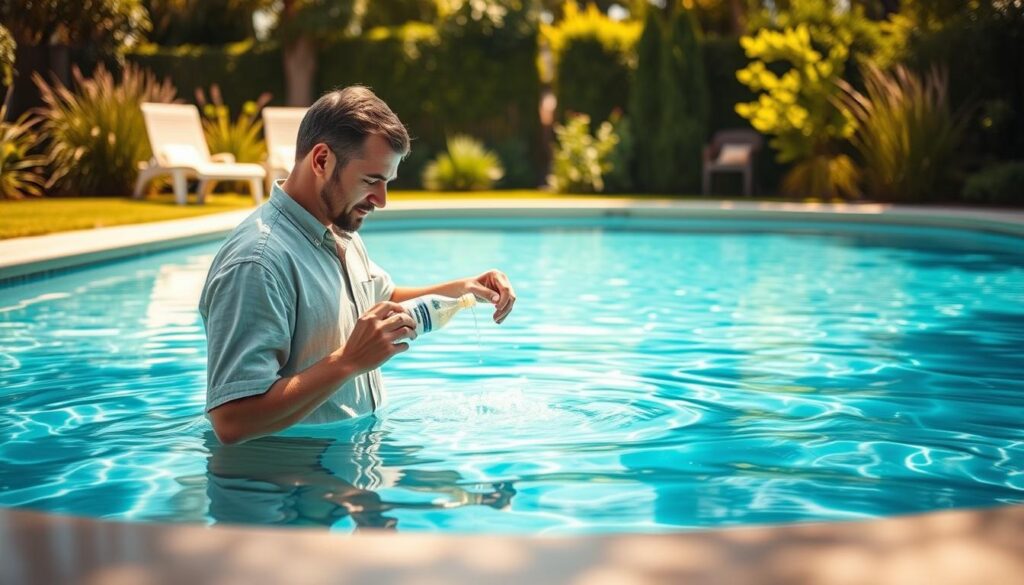
Incorporating these practices ensures that your pool remains inviting and safe, making your swimming experience more enjoyable. Embrace these nonchlorine shock usage tips to enhance your pool maintenance routine effectively.
Safety Considerations for Nonchlorine Shock
When it comes to maintaining your swimming pool, understanding the safety aspects of nonchlorine shock is critical, especially if you have children and pets. This chemical is designed to help keep your pool clean while minimizing safety risks compared to traditional chlorine products.
Nonchlorine shock safety is one of the essential considerations for pool owners. You want the space to be enjoyable for you and your family without worrying about harmful chemical exposure. Nonchlorine shock does not release strong chlorine odors, making it safer for everyone to enjoy.
Is it Safe for Kids and Pets?
Rest assured, using nonchlorine shock in your swimming pool can be safe for children and pets. Unlike chlorine, which may cause skin irritations or respiratory issues, nonchlorine options tend to have fewer adverse effects. Following best practices can further enhance swimming pool safety for your little ones and furry friends.
- Always allow the pool water to circulate and reach the appropriate levels before letting children and pets swim.
- Keep pets away from pool chemicals during application to ensure they do not accidentally ingest any substances.
- Monitor pH and chlorine levels regularly, ensuring they are in the safe range for both kids and pets.
Taking these precautions ensures a safe and enjoyable environment for everyone. Integrating nonchlorine shock into your pool care routine prioritizes the well-being of your family, providing you peace of mind during those warm summer days.

Common Misconceptions About Nonchlorine Shock
Many individuals encounter various myths about nonchlorine shock, particularly regarding its effectiveness as a sanitizing agent. Some mistakenly believe that nonchlorine shock cannot kill bacteria or handle algae growth as efficiently as traditional chlorine methods. In reality, nonchlorine shock serves a vital purpose in pool maintenance, effectively breaking down organic contaminants and improving water clarity.
Another prevalent misconception in pool care is that nonchlorine shock is unsafe for regular use. This notion can deter users from incorporating it into their pool maintenance routines. On the contrary, when used as directed, nonchlorine shock is safe for swimmers and pets. It lacks harsh chemicals that can cause skin and eye irritation, making it a gentle alternative for families.
Addressing these myths about nonchlorine shock helps ensure a more informed approach to pool care. Recognizing the facts surrounding this product allows for better decision-making, leading to a cleaner and healthier swimming environment.

Alternative Methods for Pool Care
Maintaining clean and safe swimming pool water requires a balanced approach. While nonchlorine shock is an excellent option, integrating alternative pool care methods can enhance your results. Two effective alternatives worth exploring are algaecides and clarifiers. Understanding their roles and benefits ensures your pool remains sparkling and healthy.
Using Algaecides and Clarifiers
Algaecide use can be a critical part of your pool maintenance routine. This targeted chemical works by preventing and eliminating algae growth, which can turn your clear pool water into a green mess. Selecting the right algaecide depends on your specific needs; for example, some formulas are designed for preventative measures, while others focus on combating existing issues.
On the other hand, clarifiers offer remarkable benefits for pool water clarity. They work by binding tiny particles and contaminants, enabling your filtration system to remove them more efficiently. Using a clarifier enhances water clarity and ensures a more enjoyable swimming experience. Incorporating both algaecides and clarifiers into your regular maintenance schedule can significantly improve your pool’s overall condition.
Here’s a detailed comparison of these methods:
| Method | Primary Use | Best Time to Use | Key Benefits |
|---|---|---|---|
| Algaecide | Prevents and treats algae growth | Weekly or after heavy rainfall | Enhances water quality, helps maintain balance |
| Clarifier | Improves water clarity | After heavy use or regularly | Removes fine particles, enhances swimming experience |
By understanding the benefits of algaecide use and clarifier benefits, you can create a comprehensive pool care strategy that aligns with your maintenance goals. These alternative methods work synergistically with nonchlorine shock, ensuring your pool remains a refreshing oasis.
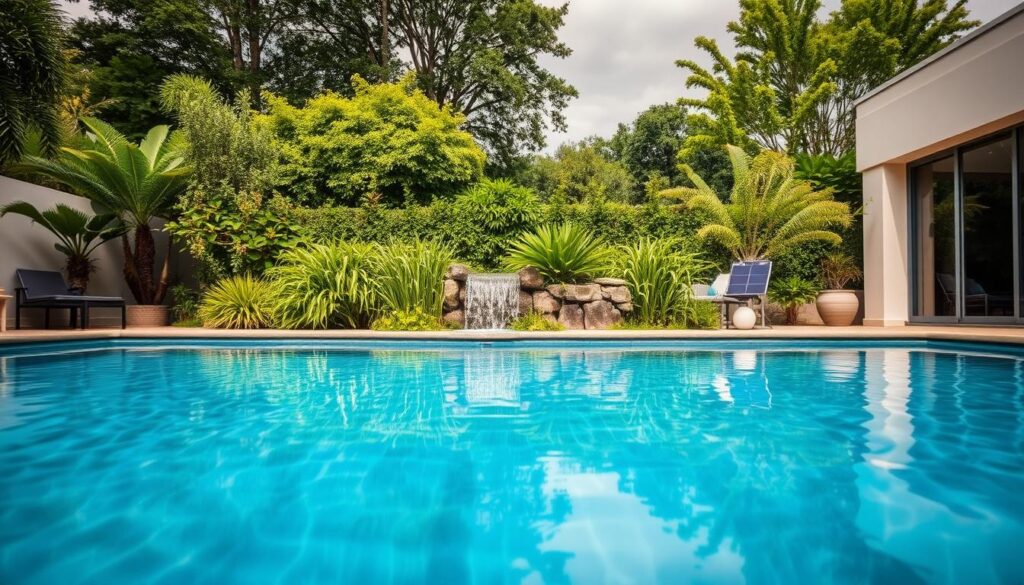
The Cost-Effectiveness of Nonchlorine Shock
When it comes to maintaining your pool, understanding the nonchlorine shock cost savings can significantly impact your budget. Choosing nonchlorine shock over traditional chlorine options often leads to lower overall chemical expenses. This shift not only provides effective sanitization but also enhances the longevity of your pool equipment, reducing the frequency of costly repairs.
The value of pool maintenance chemicals plays a crucial role in determining your pool’s operation costs. Nonchlorine shock products tend to stabilize pH levels more effectively, leading to reduced usage of additional chemicals. By purchasing fewer products and minimizing chemical waste, you can enjoy a cleaner pool and maintain a healthier swimming environment.

Consider evaluating the long-term financial benefits of adopting nonchlorine shock in your maintenance routine. Your wallet will thank you as you experience firsthand the financial relief that comes from smarter chemical choices.
Why Nonchlorine Shock is Essential for Clean Water
The importance of nonchlorine shock cannot be overstated when it comes to maintaining pool sanitation. This innovative solution effectively breaks down organic contaminants, ensuring you enjoy clean swimming pool water throughout the season. Using nonchlorine shock regularly creates a healthier swimming environment, ideal for families and visitors alike.
Nonchlorine shock serves as a powerful oxidizer. It minimizes the buildup of chloramines, which can lead to unpleasant odors and skin irritation. By employing this method, you contribute to the longevity of your pool equipment while keeping maintenance costs in check.
Overall, incorporating nonchlorine shock into your routine presents a proactive approach to maintaining pool sanitation and enhancing your enjoyment of a sparkling, clean swimming pool. Regular usage will ensure that your pool remains inviting and safe for all swimmers.

Conclusion
In summary of nonchlorine shock benefits, utilizing this product in your pool maintenance can significantly enhance water quality and overall safety. Unlike traditional chlorine shock, nonchlorine alternatives offer fewer irritants, making them a more appealing choice for families with children and pets. Additionally, their effectiveness in keeping pool water clean without harsh chemicals speaks volumes about their usability.
Moreover, nonchlorine shock products tend to be more cost-effective over time. By reducing the need for additional chemical treatments and minimizing maintenance complications, you can streamline your pool care routine. These final thoughts on pool maintenance suggest that making the switch to nonchlorine shock can lead to clearer, safer water and a more enjoyable swimming experience for you and your family.
By incorporating nonchlorine shock into your regular maintenance schedule, you’ll not only ensure the cleanliness of your pool but also create a healthier environment for everyone. Consider the several advantages it brings as you make your next pool care choice.
